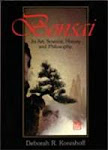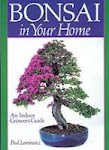 Bonsai It’s Art, Science,
Bonsai It’s Art, Science,
History and Philosophyby Deborah Koreshoff
ISBN 0908175752 HC pp.255
Published 1984
Boolarong Publications
The crown jewel of my collectionSome might disagree with me on this one, but I believe it is, without a doubt, the best-written book on the subject. This book was out of print for quite some time and hence, difficult to find, as a matter of fact because the market demand was so great for a while, used dealers took it upon themselves to make a quick buck, selling used copies at exorbitant prices, the majority of which were paperbacks. After months of surfing the net, I was fortunate enough to acquire a used hardcover copy, in excellent condition for a very good price. The publisher as ordered another print of this magnificent book and it is once again widely available to the public. If history was any indication I would not hesitate in acquiring one before the well runs dry once again.
A short biographyDeborah was born in 1957 into a world of bonsai. Her father, born in Harbin, Manchuria, was also surrounded by bonsai and absorbed the knowledge from the old Chinese gardener who tended them. From infancy, Deborah was exposed to club meetings and lectures/presentations by her parents, and had her own collection from a very early age. By the time she was 14 she was showing remarkable talent, and her first demonstration was given to the Bonsai Society of Australia.
In 1976, her parents’ Bonsai Nursery became the only authorized branch of the Nippon Bonsai-Saikei Art Institute with the authority to issue the Japanese Certificates. In 1978, Deborah became the teacher and since has travelled extensively around Australia. She has been the Education and Program Officer for the Bonsai Society of Australia and is the artist and major contributor for the magazine “Bonsai Australia”
The book starts off with an in depth introduction to the Art of Bonsai and it’s history. I believe describing the origins an important aspect of what we do; it is further my belief that we need to know where we have been in order to know how to proceed. Although the book has the usual pre-requisites, Deborah takes them a step further with, a brief history on the subject at hand, which, offers the reader some perspective and first hand knowledge on how things developed over the centuries. This type of approach in my opinion offers the reader the rationale on why we do things the way we do, far too often this approach is not used, or is to shallow, leaving the reader with more questions than answers.
Deborah’s attention to detail is second to none. The book contains hundreds of illustrations and photographs. They say a picture is worth a thousand words and no truer statement can be said about this book. The graphics are clear and further emphasized with extremely good explanations, which even a novice in the art can make out. Although, I would classify this book as intermediate, it is indeed well suited for any audience from beginner to advanced.
Although, the Nakas are known in the Bonsai World as the “bibles” I have chosen to crown Deborah’s book the same. John Yoshio Naka was one off, if not the founder of Bonsai in North America. His books are his lifelong notes on the subject and are translated from Japanese. The information contained in his books is invaluable. However, because these books were translated from his personal notes, it leaves the reader with many unanswered questions, as I found the detail insufficient at times. Bonsai Techniques Vol II seems to have remedied the situation somewhat but in no way compares to the depth of detail in Deborah’s book. I am not promoting one over the other here, as these books stand on their own merits. I am willing to say, however, that should I have purchased the “Nakas” after Deborah’s book I would have been disappointed somewhat. Notwithstanding, one has to remember the source of the “Nakas”; these were his personal notes. The perceived missing information or detail was in his head and, those whom had the pleasure of meeting John would back up my statement that he was a walking “Bonsai Library”.








































